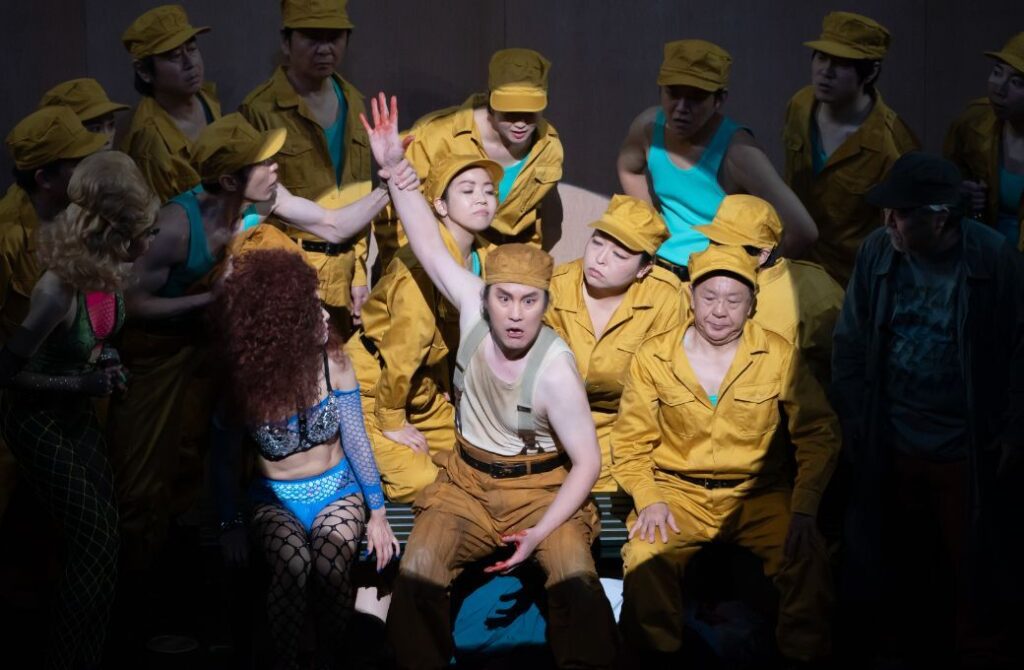Flu and other seasonal viruses had been circulating early this year in Tokyo, so it was not a huge surprise to learn that on the day I was to see Wozzeck at the New National Theatre, Tokyo, that Thomas Johannes Mayer was indisposed and that the Japanese cover, Toshiaki Komada, was to replace him in the title role at short notice. I deeply sympathise with Mayer, but this was a great opportunity for Komada, a graduate of the NNTT Opera Studio, to make a mark in this new staging by Richard Jones, and he emerged with flying colours.

Toshiaki Komada (Wozzeck)
© Ayano Tomozawa | The New National Theatre Tokyo
This is Jones’ second staging of Berg’s opera; the first one for Komische Oper Berlin (later revived at Welsh National Opera) was set in a baked bean factory, taking its cue from a line in the libretto in which the Doctor prescribes Wozzeck a diet of beans as part of his medical experiment. Although this production is set in a late 20th-century army camp, tins of beans feature in this production too (perhaps as a self-citation). In the opening and subsequent scenes, Wozzeck, a soldier at the foot of the ranks, is constantly eating from a huge can of beans and throwing the empties into a bin, symbolising the mundane hopelessness of his daily routine.
Visually, Jones’ pacy production, with set and costume designs by Anthony McDonald, is presented simply with minimal and abstract sets. He uses an array of movable box spaces which in turn serve as the soldier’s entertainment room, Marie’s house, the Drum Major’s gym or the Doctor’s consulting room. Moreover, the frequent set changes happen during Berg’s elaborately composed interludes, reflecting the fragmentary nature of Georg Büchner’s original story and articulating the unique structure of Berg’s music, formed of 15 short scenes.
Hidekazu Tsumaya (Doctor), Toshiaki Komada (Wozzeck) and Arnold Bezuyen (Captain)
© Ayano Tomozawa | The New National Theatre Tokyo
Jones emphasises the class difference of the characters by the colour of their uniforms. The superiors – Arnold Bezuyen’s Captain, Hidekazu Tsumaya’s Doctor and John Daszak’s Drum Major – are all dressed in red, whereas the rank-and-file, including Wozzeck and his friend Andres, are in yellow. It is obvious which men have the power and which are the oppressed. One could perhaps quibble that Jones over-simplifies the plot at the price of Berg’s expressionist music, but it is a universal staging to which audiences can relate.
John Daszak (Drum Major) and Toshiaki Komada (Wozzeck)
© Ayano Tomozawa | The New National Theatre Tokyo
Musically, it was a strong performance all round. NNTT Artistic Director Kazushi Ono brought in the Tokyo Metropolitan Symphony Orchestra (of which he is also Music Director) for this production, which gave a committed and intense performance with some brilliant individual playing from members of the chamber ensemble and on-stage band. Ono conducted with fierce passion and precision, bringing out the rawness of Berg’s music as Wozzeck is driven over the edge.
Komada’s singing was assured and if he had any nerves, it didn’t show. His Wozzeck is a vulnerable and submissive figure rather than a rough and aggressive one: an ordinary soldier who sinks into depression rather than madness. His voice was clear and elegant, his Sprechgesang more sung than spoken. The only thing that gave away that he was a replacement was the bagginess of his costume that had to be taken in drastically.
Toshiaki Komada (Wozzeck) and Jennifer Davis (Marie)
© Ayano Tomozawa | The New National Theatre Tokyo
Soprano Jennifer Davis, in her NNTT debut, portrayed Marie’s confused emotions with conviction and vocal finesse, trapped between her loving care for Wozzeck and the physical allure of Daszak’s Drum Major, played with macho flamboyance. Jones adds an interesting angle by bringing in a military chaplain in the scene in Act 3 where Marie’s reads from the Bible and asks for forgiveness for her adultery.
Despite the hopelessness of the story, there were some moments of humour provided by Bezuyen’s lively, gluttonous Captain and Tsumaya’s pompous, vain Doctor. Although they both abuse Wozzeck, neither is really malevolent or violent and it is their rank and power that makes them act that way. For Wozzeck, there is no way out of this bleak environment and, in despair, he kills Marie, almost casually, with a tin-can lid. As a masterstroke, Jones sets the finale as a carbon copy of his opening scene but with children: Wozzeck and Marie’s son shaving a child Captain. Plus ça change.
****1


AloJapan.com